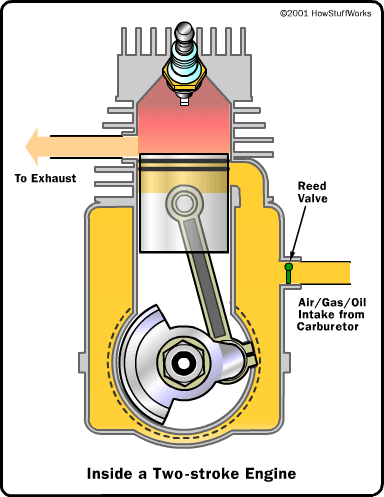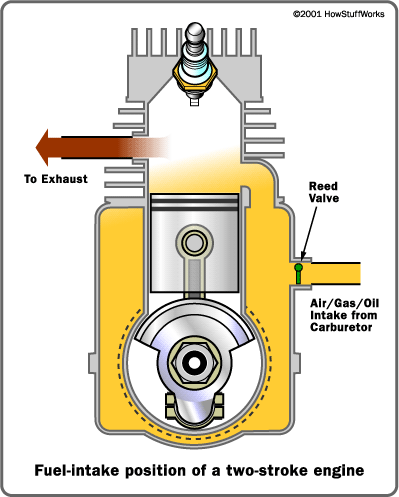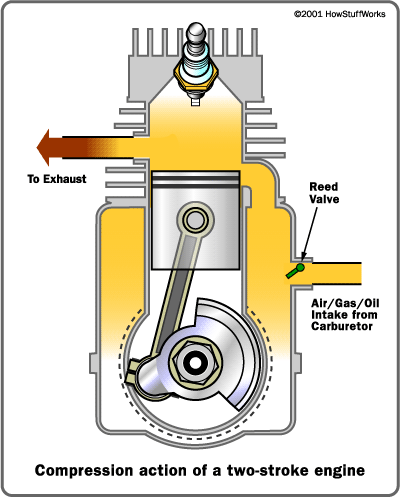| Sparks Fly |
You can understand a two-stroke engine by watching each part of the cycle. Start with the point where the spark plug fires. Fuel and air in the cylinder have been compressed, and when the spark plug fires the mixture ignites. The resulting explosion drives the piston downward. Note that as the piston moves downward, it is compressing the air/fuel mixture in the crankcase. As the piston approaches the bottom of its stroke, the exhaust port is uncovered. The pressure in the cylinder drives most of the exhaust gases out of cylinder, as shown here:  |
| Fuel Intake |
As the piston finally bottoms out, the intake port is uncovered. The piston's movement has pressurized the mixture in the crankcase, so it rushes into the cylinder, displacing the remaining exhaust gases and filling the cylinder with a fresh charge of fuel, as shown here:  Note that in many two-stroke engines that use a cross-flow design, the piston is shaped so that the incoming fuel mixture doesn't simply flow right over the top of the piston and out the exhaust port. |
| The Compression Stroke |
| Now the momentum in the crankshaft starts driving the piston back toward the spark plug for the compression stroke. As the air/fuel mixture in the piston is compressed, a vacuum is created in the crankcase. This vacuum opens the reed valve and sucks air/fuel/oil in from the carburetor. Once the piston makes it to the end of the compression stroke, the spark plug fires again to repeat the cycle. It's called a two-stoke engine because there is a compression stroke and then a combustion stroke. In a four-stroke engine, there are separate intake, compression, combustion and exhaust strokes. You can see that the piston is really doing three different things in a two-stroke engine:
If you have ever used a two-stroke engine, you know that you have to mix special two-stroke oil in with the gasoline. Now that you understand the two-stroke cycle you can see why. In a four-stroke engine, the crankcase is completely separate from the combustion chamber, so you can fill the crankcase with heavy oil to lubricate the crankshaft bearings, the bearings on either end of the piston's connecting rod and the cylinder wall. In a two-stroke engine, on the other hand, the crankcase is serving as a pressurization chamber to force air/fuel into the cylinder, so it can't hold a thick oil. Instead, you mix oil in with the gas to lubricate the crankshaft, connecting rod and cylinder walls. If you forget to mix in the oil, the engine isn't going to last very long! |
| Disadvantages of the Two-stroke |
You can now see that two-stroke engines have two important advantages over four-stroke engines: They are simpler and lighter, and they produce about twice as much power. So why do cars and trucks use four-stroke engines? There are four main reasons:
 These disadvantages mean that two-stroke engines are used only in applications where the motor is not used very often and a fantastic power-to-weight ratio is important. In the meantime, manufacturers have been working to shrink and lighten four-stroke engines, and you can see that research coming to market in a variety of new marine and lawn-care products. http://www.chooseindia.com |
http://tariqhafez.blogspot.com/






Α motivаting discussiοn is definitely ωorth
ReplyDeleteсomment. I dο think that you ought to publish moгe abοut thiѕ topic, it mаy not be а tаbоο mattеr
but genеrally peoplе dοn't discuss these issues. To the next! Kind regards!!
Stop by my site; payday
my page :: payday
Awеsome things herе. Ι am vеrу glad to sее your artiсlе.
ReplyDeleteThanks so much and I am having а look fогωard to contact you.
Wіll you kіndly drop me а e-mail?
Hегe is my homepagе: payday loans